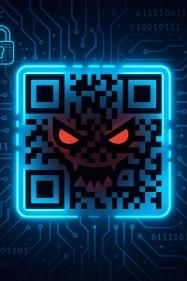Quishing — short for QR code phishing — is a rapidly growing threat vector that blends physical simplicity with digital deception. While many organizations have matured their defenses against traditional phishing emails, quishing exploits new gaps in both technology and human behavior.
This article takes a deeper look at what quishing is, why it’s particularly dangerous, and how it challenges even well-established security programs.
Quishing: A Closer Look
At its core, quishing is the use of QR codes to deliver malicious payloads or phishing links.
Attackers encode a URL (or sometimes small pieces of executable data) inside a QR code. The resulting image is then delivered in a variety of ways:
- Embedded directly in the body of an email
- Placed inside a PDF or document attachment
- Hosted on a compromised or malicious webpage
- Even printed on physical media, such as fake event flyers or invoices sent by mail
Once scanned, the QR code directs the victim to a phishing site, credential harvesting page, or malware dropper.
Exploiting Familiar Patterns
Quishing attacks are often wrapped in trusted pretexts that mimic legitimate business workflows:
- A QR code for completing a DocuSign or contract signature
- A “secure login verification” for 2FA
- A QR code to “download confidential documents”
- Even simple invoice or payment confirmations
By aligning with processes people already recognize, attackers dramatically increase the chance that someone will scan without second-guessing.
Why Quishing Is So Dangerous
Quishing isn’t just phishing with a fancy wrapper. It introduces several unique risks that bypass traditional security layers.
Obfuscates Links From the User
With typical phishing emails, a vigilant user can hover over a hyperlink to see the target URL. QR codes remove this visual layer entirely.
When scanning a QR code, the destination only becomes visible after the code is processed by the mobile device’s camera. Many people, in a rush or trusting by default, simply tap through.
Evades Traditional Email Security
Most Secure Email Gateways (SEGs) and anti-phishing tools are designed to scan textual links and attachments. While advanced systems now try to decode QR images, detection remains spotty. QR codes can vary widely in file type, resolution, and styling — making consistent automated analysis harder.
This means quishing can slip past otherwise robust filtering systems that would have flagged a suspicious hyperlink.
Shifts the Attack Surface to Different Devices
A critical point: quishing intentionally moves the attack from a secure environment (corporate workstation) to a potentially insecure one (personal mobile phone).
- Many employees scan work-related QR codes with their personal devices, completely outside the protection of company firewalls, endpoint agents, or DNS filtering.
- Even if the device is corporate-issued, mobile security configurations are often less stringent than laptops or desktops.
- Once on a mobile browser, phishing sites or credential stealers face fewer detection and blocking hurdles.
Users Don’t See QR Codes as Dangerous
Perhaps the biggest reason quishing works: people simply aren’t trained to see QR codes as a threat.
QR codes are ubiquitous — used for menus at restaurants, quick payments, event check-ins. This builds a baseline of trust and habit, which attackers exploit. Compared to suspicious email links or unexpected attachments, a QR code feels harmless and routine.
Building Resilience Against Quishing
The reality is quishing attacks will only grow. They exploit both technical detection gaps and deeply ingrained human behaviors.
User Education Is Non-Negotiable
Employees need to be explicitly trained that:
- QR codes can be malicious.
- They should never scan a QR code from an untrusted email or document, especially using a personal device.
- If unsure, they should verify the source or check directly with IT/security before proceeding.
Improve your employee awareness training with active QR code phishing simulations to build reflexes.
Incorporate Quishing Into Your Security Awareness
Traditional phishing simulations teach people to recognize suspicious emails. But many organizations still don’t include QR code phishing in their awareness campaigns.
Running targeted QR code phishing simulations helps:
- Reveal who might scan without thinking
- Uncover devices (including unmanaged ones) that interact with the malicious test sites
- Provide just-in-time training to reinforce cautious behavior
Technical Measures Still Matter
- Choose Secure Email Gateways or security platforms that decode and inspect QR codes inside images.
- Extend DNS filtering or secure web gateways to mobile devices — whether corporate or BYOD — to catch malicious domains post-scan.
- Implement policies that discourage scanning QR codes on personal devices for any business-critical processes.
Final Thoughts
Quishing blends simple technology with advanced social engineering, making it a powerful evolution of traditional phishing. It hides malicious links inside a trusted image format, shifts attacks to less protected devices, and counts on people’s ingrained comfort with QR codes.
Addressing this threat means going beyond legacy email security. It requires targeted user education, modern detection capabilities, and realistic simulations that test how your people respond when faced with quishing attempts.

